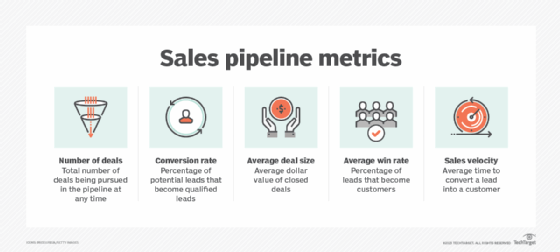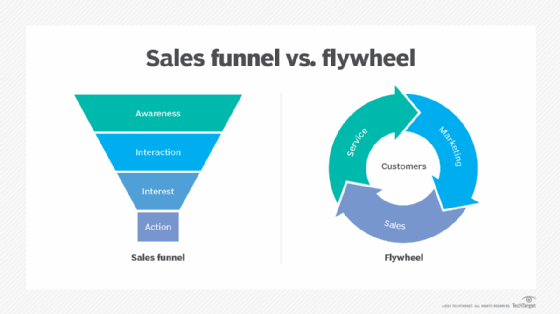What is a sales pipeline?
A sales pipeline is a visual representation of sales prospects and where they are in the purchasing process. Pipelines also provide an overview of a sales rep's account forecast and how close the rep is to making their quota, as well as how close a sales team is to reaching its quota. This lets sales reps and sales managers forecast the number and dollar amounts of deals that will close in a period.
A sales pipeline is represented visually as a horizontal or vertical bar and includes the different stages of a sales cycle. While sales pipeline stages vary depending on the industry, they usually include gathering sales leads. qualifying leads to identify likely customers, building relationships with potential customers and closing deals. The goal is to turn leads into customers.
A sales pipeline is created using Excel or Google spreadsheets, customer relationship management (CRM) software such as Salesforce and sales pipeline management software. Creating a visual representation of a pipeline is valuable for managing and optimizing the sales processes. CRM software functionality and other software also help automate certain sales tasks.
Why is a sales pipeline important?
Sales pipelines provide centralized overviews enabling sales professionals to track their progress with potential buyers. The pipeline provides visibility into every sale, as well as into the overall sale process. It can reveal obstacles that are slowing the sales process or getting in the way of completing specific sales. Sales teams can then reshape their strategies to overcome those obstacles.
The sales pipeline documents a buyer's journey through the sales process. The journey is comprised of various milestones, from the potential customer becoming aware of a product and interacting with one or more sales professionals to the prospect showing interest, finalizing a sale and becoming a customer.
The sales pipeline doesn't just present information. It also recommends ways for sales reps to convert sales leads or prospects into satisfied customers. These capabilities make sales pipelines important for sales departments.
Sales pipelines provide visual analytics that provide sales and revenue forecasts. They help sales teams synthesize details about a potential deal and then predict the value of its success. Sales teams then hone in on deals with the most projected value. Additionally, sales reps use pipelines to track their own productivity.
How do sales pipelines work?
A sales pipeline tracks the customer journey of an individual from sales lead to customer. It visualizes the lifecycle of various customer prospects, from initial interaction to deal close.
The sales pipeline can be broken down into the following six stages:
- Prospecting. The first stage of the sales pipeline is lead generation, which includes gathering new leads, projecting sales based on those leads and performing outreach to them. According to Gartner, 88% of sales professionals surveyed consider their sales team's prospecting efforts as very or somewhat effective.
- Qualifying prospects. The next stage involves turning prospects into qualified leads. Online, such prospects are called marketing-qualified leads. At this stage, leads that are likely to become new customers are identified. A process called lead scoring is used to assess factors such as the needs and budget of a lead.

- Engaging with a lead. Interaction with leads helps determine if there are enough common interests to begin building a relationship. This stage often involves email and social media campaigns, including LinkedIn outreach, cold calling, creating strategic content such as webinars and making use of a salesperson's network.
- Building a relationship. This stage is also called lead nurturing. It's where the sales rep gets to know a lead on a deeper level through scheduled meetings, product or service demos and price quotes. Leads that have entered this stage of the pipeline are considered sales-qualified leads and possible sales opportunities.
- Negotiating with the lead. This happens once the prospect is ready to buy a product or service. This stage includes addressing questions and concerns from the potential customer and possibly compromising on price and service.
- Closing the deal. This could involve completing a deal, losing it or putting it on hold. Putting a deal on hold often happens when a prospect still has purchase intent but isn't ready to buy. In this case, the sales rep continues to foster the relationship.

How to measure the quality of a sales pipeline
A healthy, effective sales pipeline is often determined by pipeline metrics. Tracking metrics such as the following lets sales team members identify areas of the process they need to adjust:
- Number of deals in the pipeline. This metric is the total value of potential deals with leads in an organization's pipeline. It's used to predict revenue and identify whether a sales team is meeting its sales forecast.
- Conversion rate. This metric is also called the lead to opportunity ratio. It measures the percentage of potential leads that have become qualified leads with whom the company is pursuing deals. To obtain this number, divide the number of successful leads by the total number of leads available during a given period, then multiply the answer by 100. Conversion rate optimization indicates whether a sales team is effective in lead qualification and engagement.
- Average deal size. This number reflects the average dollar value of the deals a sales team closes in a period of time. This metric lets companies identify which products and services they're most effective at selling.
- Average win rate. This metric indicates how many leads are converting into customers. It's one of the most important in measuring the quality of a pipeline and helps managers assess the performance of individual salespeople and identify sales leaders.
- Sales velocity. This metric is also called sales cycle length. It is the average total time it takes a sales pipeline to convert a lead into a customer. Sales velocity can vary by product and service. It also indicates whether there are bottlenecks in the pipeline.

How to improve sales pipeline conversion rates
Conversion rates are an important way to gauge the effectiveness of a sales team's outreach strategy. There are various ways to improve a lackluster conversion rate, such as the following:
- Envision the ideal customer. Tailoring a sales strategy to target audiences with specific product needs is an important tactic. Buyer personas are often used to ensure sales teams understand their target audience and its needs.
- Create compelling, personalized sales content. Once the customer is understood, compelling sales content should be crafted to explain why a product addresses the customer's needs. The content should be personalized for the target audience.
- Use multiple channels. A sales team should take an omnichannel approach that uses a variety of ways -- such as email, webinars, social media and basic phone calls -- to engage with qualified leads. This shows that a sales team understands how its prospective customers prefer to be reached.
- Follow-up interactions. Continuing to engage with qualified leads keeps their interest and guides them through the stages of a sales pipeline.
- Continuous tracking and optimization. Even after a deal closes, tracking conversion rate improvement and other metrics should be a continuous process. A sales team should periodically measure conversion rates to see how they improve over time.
How to build a sales pipeline
There are five steps involved in building a sales pipeline:
- Identify the target customers. The first step in any sales process is determining who the target customers are. This stage involves market research, customer segmentation, understanding a customer's potential needs and pain points, and creating an ideal customer profile.
- Define the pipeline. Various metrics should be used that are pertinent to the pipeline at issue. In most cases, the sales cycle length depends on the complexity and customization requirements of the product or service sold. Forecasted sales targets are determined at this stage so a sales team can effectively plan their sales goals for a quarter. Also, the various stages of the pipeline are defined, including the activities a salesperson should expect to engage in as part of the sales process.
- Generate and qualify leads. This step involves identifying and targeting potential leads through email, social media, phone, existing networks and trade shows. Qualified leads are ones that are likely to buy a product or service. This involves using lead scoring best practices to assess potential customers' needs, interests and budgets.
- Identify where leads are in a pipeline. Engagement with a lead results in anything from an immediate request for a demonstration, to price quotes and negotiation or simply more information. What the leads ask for determines where they fit in the pipeline.
- Track sales pipeline metrics and performance. Sales pipelines are constantly changing. A successful one depends on careful tracking of its metrics and performance and adjusting the process as needed. For instance, not all leads convert into customers, and old and stagnant deals should be removed from the pipeline when it's determined they're unlikely to close. Stages of the pipeline should be refined, removed or even added. Finally, an accurate assessment of metrics such as conversion rate and sales velocity are crucial to projecting sales forecasts and identifying how many deals a team must close in a quarter to meet revenue goals.
How to maintain a sales pipeline
Maintaining a sales pipeline involves several key steps:
- Follow up with leads. Following up with leads is crucial to building strong relationships and increasing the chances that leads become customers. The sales team should identify the decision-makers who are the most valuable leads to their business and ones that are most likely to convert. Managers should drop leads from the pipeline that are no longer moving from stage to stage. Strong customer analytics can help improve lead generation and engagement.
- Create a standardized sales process with short cycles. It's important to clarify sales activities to sales teams and create a standardized process for them to follow. This helps avoid confusion, aligns salespeople with a common sales strategy and optimizes their activity. Short pipeline cycles can keep leads from losing interest.
- Monitor, review and manage the pipeline. A pipeline can grow fast, and its effectiveness can change over time, depending on leads and the state of the market. For a pipeline to remain effective, an organization must monitor the performance of key metrics and watch for problems and bottlenecks. Sales CRM and sales pipeline software can help streamline these tasks.
- Build content. Building relevant marketing content is critical to attracting potential customers and nurturing leads. Some potential customers require more detailed information and content than others. Typical content provided to potential customers includes blogs, white papers and features that speak with independence and authority about a type of product or technology. As potential customers move further along in the sales pipeline, they might require content focused specifically on a company's own product or service.
Sales pipeline vs. sales funnel vs. sales flywheel
A sales pipeline is often compared to a sales funnel; however, they are different. A sales funnel is a funnel-shaped visualization of the buyer's journey from the discovery of a product or service to purchase. The funnel shape visually shows that only a small number of leads become customers.
Both pipelines and funnels are focused on converting leads into customers. However, sales funnels are concerned with the journey from the buyer's perspective, identifying what information potential buyers need at specific points along the way. The sales pipeline focuses on the process from the business's and marketer's point of view, identifying what they must do at specific points.
Sales funnels are frequently used to guide the creation of search engine-optimized content that attracts leads and converts them into customers. Marketing teams target the content they create at leads in specific parts of the sales funnel. In doing this, they consider the potential customer's interests at that point in their journey through the sales process.
Sales funnels are also often compared to sales flywheels. Unlike sales funnels, which are wide at the top, indicating the large number of leads that don't become customers, the sales flywheel is designed to put customers at the center of the process. Flywheels focus on the customer experience and the fact that each part of the sales cycle feeds into the next part.

Personalized marketing is becoming increasingly important as sales teams compete for customers' attention. Learn the different types of marketing personalization.






